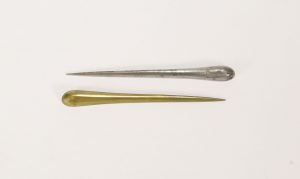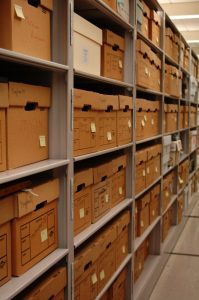The BackBlog: Elisha Perkins and the Metallic Tractors
When I found these strange metal objects in one of the first boxes that I opened from the backlog, I knew exactly what they were. These were Perkins tractors: one of the strangest medical fads I had ever heard about.
In 1796, physician Elisha Perkins began selling a new therapeutic device called the Perkins tractor. These tractors were teardrop-shaped metal rods that were about three inches long and flat on the bottom. They were sold in pairs, with one tractor made of iron and the other made of brass. By merely touching these rods to your skin, Perkins claimed, you could cure rheumatism, inflammation, epilepsy, and any number of other medical maladies. The best part of all? There was no need to be a trained doctor in order to use them. All anyone had to do was touch the devices to the afflicted area, and their symptoms would disappear.

A pair of Perkins Tractors, circa 1800. From the Warren Anatomical Museum in the Center for the History of Medicine, Francis A. Countway Library of Medicine (LEAN0011)
It might seem obvious to a modern reader that these cure-all devices were too good to be true, but in the late 18th and early 19th century, they were a massive hit. While there were certainly detractors—Perkins was expelled from the Connecticut Medical Society shortly after he began marketing the device—many physicians and noteworthy members of society endorsed his invention. Perkins tractors were sold to physicians and congressmen. Even George Washington bought a pair. The sales were so successful that Perkins quickly branched out to Europe. While Elisha Perkins sold the tractors at home, his son Benjamin Perkins went to England to sell them there, and continued to do so after his father’s death in 1799. The family made quite a bit of money off them. Perkins tractors were sold for $25 a pair–close to a $500 value today.
In the end, however, the skeptics won. Many scientists and doctors felt that the devices were nothing but quackery. Multiple English physicians conducted tests in which some of their patients were treated with genuine Perkins tractors, and some were treated with instruments made of other materials. These physicians all found that all materials were equally effective, so long as the patient believed that they were being treated with genuine Perkins tractors. These were likely some of the earliest experiments into what we know today as the placebo effect: the idea that a person’s body can have a response to a treatment simply because they believe that it will work.
After these experiments were publicized, the Perkins tractors were ridiculed throughout society. Scholars published papers about their ineffectiveness. Poets and cartoonists lampooned the treatment in magazines and newspapers. Eventually, the tractors fell out of fashion, and people stopped using them.
Living in the 21st century, it’s easy to laugh off the Perkins tractors as obvious quackery. However, it’s important to remember that at the time it wasn’t so obvious. Although there were some skeptics, highly educated people fell for these devices. Cases like these remind us that if something seems too good to be true, it very well might be. And 200 years from now, we might be the ones someone’s laughing at.
